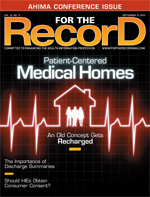 September 13, 2010
September 13, 2010
Technology Helps Rural Clinic Thrive
By David Yeager
For The Record
Vol. 22 No. 17 P. 40
Sister Anne Brooks, DO, has gotten used to doing more with less. At Tutwiler Clinic in Tallahatchie County, Miss., she’s one of four doctors who see patients from seven counties. Many can’t afford to pay for care, and many don’t qualify for Medicare or Medicaid. And the generally low education level among her patients means Brooks and her staff spend a lot of time talking about healthful lifestyle choices and explaining medication schedules.
For this reason, she’s hoping a change in her office will reduce something that she doesn’t need more of: paperwork. The clinic, which handles 8,000 patient visits per year, recently implemented a Sage Intergy EHR system that Brooks anticipates will allow the clinic staff to deliver more care in less time.
“As we are able to get patients in the rooms more quickly and we’re able to address their needs more easily, that’ll give us more time to listen to the patient. I think that’s one of the things that’s missing in medical care,” she says. “We’re busy doing tests, but we don’t listen to the patient. And sometimes the answer is just right there in what the patient tells us. It also will give us more time to teach.”
New reduced pricing from Sage, a couple of bequests, help from donors, and a local IT volunteer have allowed Brooks to upgrade from Sage’s legacy Medical Manager EHR. Broader recording capabilities will allow medications, diseases, and patient outcomes to be tracked more specifically and give the clinic a better opportunity to meet these important components of federal meaningful use guidelines. Unfortunately, only about 15% of her patients qualify for Medicare or Medicaid, 15 percentage points below the level required by the Centers for Medicare & Medicaid Services to qualify for meaningful use incentive funds. But even though the clinic doesn’t currently qualify for those federal monies, better tracking can potentially lower costs over the long term by helping physicians spot developing patterns and address them when they require less treatment.
Lowering costs is an important consideration for any healthcare provider but even more so at the Tutwiler Clinic. Located in the rural Mississippi Delta, jobs are scarce and many residents lack a high school diploma. Although poverty statistics have improved over the past few years, Brooks says they’re skewed because many poor residents have moved north, while wealthy landowners have stayed. This makes applying for grants a challenge because the statistics suggest the area is more affluent than it actually is. Because funds are hard to come by, any cost savings help keep the clinic properly staffed.
Brooks says staff pay is, by far, the clinic’s biggest expense, but it’s money well spent. In addition to Brooks, the clinic employs another physician, Narayan Bhetwal, MD, and a nurse practitioner, Sister Eileen Breen, OP. There are several nurses and three aides who help run the clinic.
But lack of money doesn’t prevent Brooks and her colleagues from helping as many people as possible. The staff visits patients in hospitals, nursing homes, or in their homes. They even pick up patients, if necessary, and drive them to specialist or hospital appointments.
“The practice is quite busy because of all those other opportunities to deliver healthcare,” says Brooks.
The clinic provides ancillary services to help patients monitor their health. Several specialists see patients at the clinic on a regular basis. A dentist comes every Wednesday, an eye doctor comes once per month, and a podiatrist visits quarterly. Brooks says these services are crucial for catching problems early and educating patients. Dental checkups provide an opportunity to discuss diet; people with poor dentition tend to favor soft, starchy foods, which can lead to sugar imbalances. Vision and foot checkups can also reveal incipient problems.
“The more they understand what’s going on, the more they are empowered,” says Brooks. “For health, you’ve got to be empowered.”
Brooks tries to empower her patients by providing as much information as possible. Diabetes and hypertension are the most common health issues at the clinic, partly because most patients need to be educated about healthful choices. Fried fatty foods are a dietary staple in the delta; there’s also a high rate of alcohol abuse. With all these challenges, she hopes the EHR will open more avenues for patient education.
She expects the technology to help her provide better care through features such as patient reminder protocols that present relevant patient information in a drop-down box categorized by age and gender. The EHR allows multiple users to view the same chart at the same time. Sage Intergy can interface with lab results so they don’t have to be entered manually, freeing lab technicians for other duties; a similar feature for electrocardiogram results may eventually be added when the clinic can afford it. In addition, the system has predesigned anatomical pictures that allow doctors to show patients what’s going on inside their bodies. Physicians can draw on the pictures and patients can take them home.
“We want to empower our patients for health, but I think that the electronic health record will empower us to empower our patients for health in many, many ways,” says Brooks.
— David Yeager is a freelance writer and editor based in Royersford, Pa.



